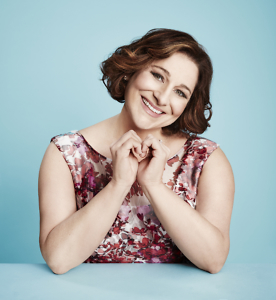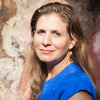Reading to Reset
Jennifer Weiner talks with Chapter 16 about her debut book for children
“Everyone here has something” is a message that appears several times in Jennifer Weiner’s debut middle grade novel, The Littlest Bigfoot, the first of a trilogy mixing mystery, adventure, and coming-of-age themes. Twelve-year-old Alice Mayfair never fit in anywhere—not in her family, not in her neighborhood off Manhattan’s Central Park, and not in any of the many schools she has attended. When her chauffeur drops her off in the middle of a forest in upstate New York at The Experimental Center for Love and Learning, she finds an unlikely soul mate in a young Yare girl (a member of the species known more commonly as Bigfoot) and learns that friendship, like friends, can be very different from what you first expect.

In advance of her appearance at The Booksellers at Laurelwood in Memphis, Weiner recently answered questions from Chapter 16 via email about writing for young readers and how books can be a “reset” button in their lives.
Chapter 16: What was the biggest challenge for you in shifting from an adult perspective to writing from a child’s?
Weiner: When I was writing The Littlest Bigfoot, I just did what I do with my adult fiction—try to tell the story as best I can, try to make the characters feel fully realized and believable, try to have a plot that’s going to keep readers engaged. Sometimes I would think about language or structure—would an eight-year-old know this word? Is this too much description for a ten-year-old?—but for the most part I just tried to write Alice and Millie’s story in a way that would be as clear and compelling as possible.
Then I turned a draft in to my editor and I learned that what I’d written was about twice as long and had three times as much going on as a typical middle-grade title. At some point what was supposed to be just one book became a trilogy, and then I focused on making sure that this was a book that would work for its intended audience. I made sure the chapters were on the shorter side, and that each one ended with some version of a cliff-hanger. I went through it, paying attention to the language and the length of the descriptive passages.
I actually workshopped The Littlest Bigfoot in my daughter’s first- and second-grade classrooms. I’d show up as the “guest reader,” read about ten minutes of whatever chapter I was working on, and pay close attention to when the kids started squirming. Then I’d go home and take the squirmy passages out! I learned that writing for this age group is kind of Elmore Leonard—take out the parts that no one wants to read, and get back to the action!
Chapter 16: As a writer you are known for your humor, particularly in characterization. Does humor work differently when writing for young readers, who are still learning the difference between laughing at someone and laughing with someone?
Weiner: I hope that, in addition to the broadly funny scenes (poor Jeremy trying to read his Bigfoot report with kids making armpit farts and asking what’s going to be on the test), there are descriptions that will help kids become more discerning about how humor works and why things are funny. For example, when Lori and Phil are earnestly explaining that the Experimental Center “tolerates everything except intolerance,” I think adults will understand immediately who, or what, is being satirized, but I hope that kids will take some time to unpack it and think about the ways that Lori and Phil aren’t just characters, or even caricatures, but about why they’re funny, and what the Experimental Center itself is meant to satirize.
Chapter 16: The Littlest Bigfoot deals with bullying, particularly in the form of body shaming, and you recently wrote an op-ed piece for The New York Times about the ways in which nude or provocative photos were wielded during the Republican primary season. What do you hope young readers will learn from this book about the power play over the female body?
Weiner: As I’m writing this, there’s a picture making the Twitter rounds which shows the cover of Boys’ Life magazine reading “Explore Your Future,” with pictures of jets and calculators and microphones, and the cover of Girls’ Life with headlines reading “Your Dream Hair” and “Fall Fashions You’ll Love.” This is the world our kids are living in.
 There are so many messages out there that tell girls, every day, that their looks matter more than their intelligence or their skills or their accomplishments; so many messages that tell them that their hair or face or body is the wrong kind of hair or face or body and that they have to fix it.
There are so many messages out there that tell girls, every day, that their looks matter more than their intelligence or their skills or their accomplishments; so many messages that tell them that their hair or face or body is the wrong kind of hair or face or body and that they have to fix it.
I wanted this book to be a dissenting voice, a kind of “reset” button—or at least as an alternative to so much of what girls see and hear. I wanted Alice’s larger body to be not just accepted but envied and celebrated by Millie and the Yare, in a way that would help Alice—and readers—understand how subjective beauty can be. In Alice’s world, it’s the very thin female bodies that are prized, while in Millie’s world it’s the big, strong bodies that are valued. In both cases, it’s arbitrary. There’s nothing inherently better about one body or the other (except the Yare need to be big and strong so that they can run away!), and I hope The Littlest Bigfoot will help kids, and girls especially, think about that and maybe reframe their own ideas about what’s beautiful, and what’s the “right” kind of body to have.
Finally, I wanted Alice to be a runner, to learn to appreciate her body for what it could do, to show how her strength and her speed let her literally save her friend’s life. I think that if this book had been around when I was a girl, it might have helped me see my own body differently, and I hope it will help girls my daughters’ age feel better about themselves.
Chapter 16: Middle-grade novels often feature well-imagined characters who attract readers across gender. (My nine-year-old son picked up this book immediately and said, “Cool, can I read it?”) How does writing for children change the nature of writing about gender—if it changes anything at all?
Weiner: First of all, hooray for your son! My hope, and belief, is that kids are much more open-minded than we give them credit for—that boys don’t have any innate bias against picking up a book with a girl on the cover, and that we’re the ones bringing our own biases to the table and forcing them on our daughters and our sons.
I knew that I wanted this to be a book where girls were the leading characters, where a girl had the hero’s role, because I think that still too often we expect girls to read books with male protagonists and put themselves in the boy’s place, and we don’t have the same expectation of boy readers (and this plays out in the adult world, where women read fiction by men and women, but there are many men who won’t pick up a book by a woman).
But I also knew that I wanted a boy to be part of the story, and that he’d be dealing with his own insecurities and feelings of not measuring up. There’s something so universal about feeling like you don’t fit in, that everyone’s got it figured out but you, and it was important for me to show that reaching across the gender divide.
Chapter 16: In 2010 you called attention to white male privilege in the literary world by coining the term “Franzenfreude,” which you defined as “taking pain in the copious reviews being showered on Jonathan Franzen.” The cause was taken up by other bestselling writers, including Jane Smiley, and since then the yearly VIDA count has shown significant movement toward gender parity at many publications, including The New York Times Book Review. How would you characterize the critical landscape for female novelists today?
Weiner: I think it’s one step forward, one or two steps back. On the one hand, we have the VIDA count, which is essential for holding newspapers and magazines accountable, and not letting editors say, “Oh, things aren’t that bad,” or, “We’re committed to doing better,” when they’re not. There has been tremendous progress at The New York Times. At the Sunday Book Review, Pamela Paul seems to have effortlessly corrected the gender imbalance—without resorting to quotas or covering less-worthy, less-literary writers, the way some people worried that she would. She launched the “Short List,” which is a place where commercial women’s fiction sometimes gets reviewed, and it was recently announced that she’s going to be in charge of all book coverage, across the paper, which means that the daily critics will know what their weekly colleagues are reviewing, and vice versa. No more two-reviews-and-a-profile for the same handful of well-connected white guys (or, if it does happen, at least it will be intentional, and not accidental).
However. Last Sunday, the paper reviewed several very serious nonfiction books about dating and marriage in the Fashion & Style section, with the headline “Sex and Dating: Now the Thinking Gal’s Subject,” and with a male editor giving his perspective on why so many women are interested in the topic. (My guess is that if an editor assigned a story about four books by men on the same topic, it would have run in the Arts section, beneath a very different headline).
If you are a female writer of popular fiction, it is hard not to notice that the Times has regular columns devoted to thrillers and mysteries, horror and science fiction—but nothing for romance, and nothing for the catch-all that is commercial women’s fiction. Romance is by far the best selling of all genres, and the Times more or less ignores it. And if you’re a reader of literary fiction, it’s hard not to see how slowly places like Harper’s and The Atlantic and even The New Yorker are taking to get their tallies close to fifty-fifty.
So there have been improvements, and there’s undeniably more awareness about the extent of the inequity. But there’s still plenty of work to be done.

Beth Waltemath graduated with a degree in English from the University of Virginia and worked at both Random House and Hearst magazines before leaving publishing to attend Union Theological Seminary in New York City. A Nashville native, she now lives in Decatur, Georgia.





